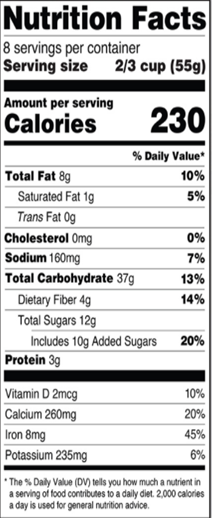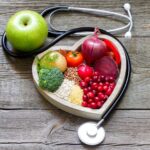Lower your cholesterol and triglycerides levels by adopting a simple diet guide
Adopting a healthy diet is one of the key steps in managing dyslipidemia and controlling cholesterol and triglyceride levels. Many foods can be a source of cholesterol or other lipids that lead to or worsen dyslipidemia, so if you have dyslipidemia, you should pay close attention to what you eat.
Do not forget to talk about your diet with a doctor and/or dietitian. He or she will be able to answer all your concerns and advise you on the best diet to adopt based on your health profile!
What foods should I avoid?
The American Heart Association advises limiting the intake of saturated fats.1
A. Saturated fatsare directly responsible for increases in bad cholesterol and triglycerides. Here is a list of foods containing saturated fats to avoid1:
- Fatty beef
- Lamb
- Pork
- Poultry with skin
- Beef fat (tallow)
- Lard and cream
- Butter
- Cheese and other dairy products made from whole or reduced fat (2%) milk
- Fried foods
In addition to saturated fats, your dose of added sugars must also be limited. There is an important difference between natural sugars and added sugars.
Natural sugars are found in vegetables, fruits, and grains, which are good for your health.
B. Added sugarshave been proven to increase the risk of obesity, diabetes, and high cholesterol and triglycerides. 2 Added sugars are often found in the following products:
- Sugar-sweetened beverages (soda and energy drinks)
- Syrup, cane juice
- Baked items (cakes, muffins, pies, cookies)
- Ice cream
- Candy
- Sweet tea and coffee 3

Did you know?
American heart association recommends not to exceed 36 grams of added sugar for men and 25 grams for women daily (which correspond to respectively nine teaspoons for men and six teaspoons for women). 4
High sugar intake puts both men and women at risk of diabetes, hypertension, and weight gain. Large amounts of sugar overload the liver and result in a greater accumulation of fat. All these risks are directly linked to increased chances of developing cardiovascular disease (CVD), heart attack, and stroke. 5.5
The table below shows the average teaspoons of sugar per beverage14:
| Drink type | Average qty of sugar (grams) | Average teaspoons of sugar |
| Flavored fruit drink (250 ml) | 27+ | 6.5 |
| Energy drink (600 ml) | 36+ | 8.5 |
| Soft drink (can, 375 ml) | 38+ | 9 |
| Soft drink (1.25-liter bottle, 1,250 ml) | 140+ | 33 |
- Two liters a day of water is recommended to maintain a healthy diet.
- Alcohol consumption should be limited, as excessive alcohol raises triglyceride levels and lowers good cholesterol levels. 6
C. Alcohol:The US government recommends drinking, only if necessary, up to one drink per day for women and up to two drinks per day for men—and only by adults of legal drinking age. 6 Different drinks have different amounts of alcohol. A one-drink equivalent is described using the following reference beverages6:
- 0.35 l of regular beer (5% alcohol)
- 0.15 l of wine (12% alcohol)
- 0.04 l of 80 proof (40%) distilled spirits
D. Sodium 7increases your risk of heart failure and stroke. Sodium is a mineral regulated by the kidney that helps to control the body’s fluid balance. Extra sodium in your blood leads to hypertension, as it increases the flow of blood into vessels. 8 It is recommended to have below 2,300 mg/day of sodium. 7 Sodium is heavily linked to salt, the consumption of which should be reduced, as more than one teaspoon of salt will exceed the daily required intake of sodium. 7 Examples of high-sodium foods are as follows: 7
- White bread
- Pizza
- Snacks (chips, popcorns, pretzels)
- Canned soups
- Sandwiches
- Egg dishes
What foods should I eat to lower my high cholesterol and triglyceride levels?
A. Polyunsaturated and monounsaturated fat: Not all fats are bad. Instead of having saturated fats, choose products with healthy fats. Healthy fats, such as polyunsaturated and monounsaturated fat, will decrease your level of bad cholesterol and triglycerides and your risk of heart attack. 9 The following foods contain healthy fats:
- Olive, canola, peanut, and sesame oils
- Avocados
- Olives
- Nuts (almonds, peanuts, macadamia, hazelnuts, pecans, cashews)
B. Omega 3: Eating fish is a powerful weapon to lower your high cholesterol and triglyceride levels, as it provides omega 3 to your body. Omega-3 fatty acids are necessary for the body to normalize lipid metabolism, as they reduce triglyceride levels and increase good cholesterol levels and high-density lipoproteins. The following fish contain a high level of omega 3: 10
- Salmon
- Cod liver
- Mackerel
- Tuna

Be careful: not all fish are good for your health. More accurately, seafood, especially shrimp, crab, and clams, are high in cholesterol and should be avoided by patients. 11
C. Fiber: Eating plenty of fruits and vegetables is also highly recommended to limit your risk of heart disease. In addition to natural and healthy sugars, some fruits offer much fiber. Fiber is important for your health, as it helps prevent CVD and lowers your cholesterol and triglyceride levels. It is recommended to eat more than 30 g per day of fiber. 12 Below are some foods high in fiber: 12
- Wholegrain breakfast cereals, whole-wheat pasta, wholegrain bread and oats, barley, and rye
- Fruits, such as berries, pears, melon, and oranges
- Vegetables, such as broccoli, carrots, and sweet corn
- Peas, beans, and pulses
- Nuts and seeds

Keep an eye on the food label!
Many foods contain information about their chemical and nutritional composition located on the back of their packaging. 13 Here are some examples of information to look for.

- Look at the serving size. This will give you good insights into the single and overall serving size.
- Check the total calories. Keep a diet under 2,000 calories a day.
- Lower certain nutrients. Check the percentage and limit your intake of saturated fats, sodium, and added sugars. Try to eat foods with 5% or less of those nutrients.
- Increase certain nutrients. Eat more calcium, fiber, and potassium. Try to eat foods with 20% or more of those nutrients.
Consult with your doctor and discuss with him which diet suits you best.











